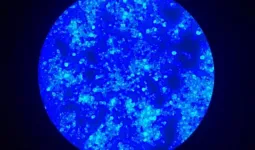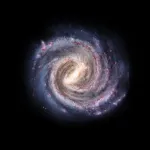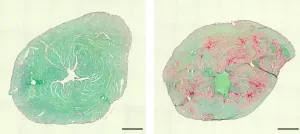(Press-News.org) International team used the stomach bacteria Helicobacter pylori as a biomarker for ancient human migrations
DNA sequences catalogued at University of Warwick in EnteroBase, a public genomes database, demonstrate that a migration of Siberians to the Americas occurred approximately 12,000 years ago
Project began in 2000s but new statistical techniques allowed researchers to reconstruct and date the migrations of Siberian Helicobacter pylori
Early migrations of humans to the Americas from Siberia around 12,000 years ago have been traced using the bacteria they carried by an international team including scientists at the University of Warwick.
Using samples of a stomach bacteria called Helicobacter pylori, which has shared a tight co-evolutionary relationship with humans for at least the past 100,000 years, analyses using new statistical techniques provide evidence that humans colonised the Americas through a pre-Holocene migration of evolutionarily ancient northern Eurasians across the Bering land bridge.
The study entitled "Helicobacter pylori's historical journey through Siberia and the Americas" is published this week (14 June) in the prestigious international journal Proceedings of the National Academy of Sciences of the USA (PNAS) by a team of researchers led by Professor Yoshan Moodley at the University of Venda, South Africa.
The research used genetic information on H. pylori catalogued in EnteroBase at the University of Warwick to trace the evolutionary history of the bacteria. H. pylori is a stomach bacteria that infects approximately half of individuals worldwide, but scientists have found that its genetic sequence also varies with the region that it is identified in.
Previous analyses had identified three populations of H. pylori from individuals in Eurasia and the Americas, and current data demonstrates that H. pylori from Siberia define additional previously unknown subpopulations of those groupings. The data also indicated one of these bacterial populations, which includes H. pylori from indigenous Americans, was distributed over the breadth of Siberia, suggesting that this population may have travelled with humans to the Americas at some point.
However, classical statistical analyses of the sequences were partially inconsistent with each other. To reconstruct the most likely evolutionary history for H. pylori in Siberia, researchers compared the most likely evolutionary models and timings using a technique called approximate Bayesian computation (ABC). The results showed that a tiny population of H. pylori colonised the Americas in a single migration event approximately 12,000 years ago.
Professor Mark Achtman of Warwick Medical School at the University of Warwick, senior co-author on the paper, said: "This project began in the early 2000s, when nothing was known about the genetic diversity of Helicobacter pylori in central Asia. By 2007, hundreds of Siberian H. pylori strains had been cultivated and selected genes had been sequenced. But repeated attempts by multiple talented population geneticists failed to shed light on their evolutionary history.
"This study now uses the powerful approach of ABC statistics to reconstruct and date the migrations of Siberian H. pylori (and their human hosts) across Siberia and to the Americas."
Originally, all modern humans came from Africa. About 60,000 years ago small groups of hunter-gatherers left Africa on foot and made their way into Eurasia where they settled. These were the world's first human immigrants. Astonishingly, by the end of the ice age some 50,000 years later, modern humans had already reached the American continent which, if travelling over land, is almost as far away from Africa as it is possible to get.
These ancient human migrations took place during the last glacial period, or ice age, which lasted from 115,000 to 11,700 years ago. At that time, most of northern Eurasia, also known as Siberia, would have been a frozen wasteland, and presumably inhospitable to long-term human settlement. So how then, did humans manage to migrate across this vast region and find their way to North America? This is one of the most important, and as yet unanswered, questions in human prehistory, because it would explain how humans were able to colonise the whole world from an African origin, in such a short space of time.
The team took the unusual approach of using the DNA of a human stomach bacterium named Helicobacter pylori as a biomarker for ancient human migrations. They successfully collected, sequenced and analysed bacterial strains from indigenous people across Siberia and the Americas. The bacterial DNA sequence database they generated suggested that, remarkably, some groups of humans, known as ancient northern Eurasians, did manage to reside in Siberia throughout the bitter ice age. Yet, other human groups who originally inhabited warmer latitudes in Asia, colonised Siberia after the end of the ice age, leading to the complex mix of human populations we see in that region today.
The team also used their bacterial data set to model human migration into the Americas. It is important to remember that during the ice age, much more water was frozen at the earth's poles, making the sea level at that time over 100 metres lower than the present-day sea level, thus exposing a land bridge between Eurasia and North America and allowing human migration. The team showed that one small group of ancient northern Eurasians managed to successfully cross this land bridge about 12,000 years ago, and this population subsequently expanded to give rise to the indigenous Americans we see today.
INFORMATION:
* 'Helicobacter pylori's historical journey through Siberia and the Americas' will be published in Proceedings of the National Academy of Sciences, Link: https://www.pnas.org/cgi/doi/10.1073/pnas.2015523118
* This research involved an international team of researchers from the University of Venda, University of Ferrara, Research Institute for Physical-Chemical Medicine (Moscow), Pirogov National Medical and Surgical Center (Moscow), University of Warwick, Instituto Politécnico Nacional (Mexico City), University of Cambridge and Friedrich Alexander University Erlangen-Nuremberg
Notes to editors:
PNAS provides journalists with access to embargoed content through EurekAlert!. Journalists should register with EurekAlert! at https://www.eurekalert.org/register.php and request access to PNAS materials. If they are already registered with EurekAlert!, they can request access to PNAS at https://www.eurekalert.org/account.php.
For interviews contact:
Peter Thorley
Media Relations Manager (Warwick Medical School and Department of Physics) | Press & Media Relations | University of Warwick
Email: peter.thorley@warwick.ac.uk
Mob: +44 (0) 7824 540863
Certain patients with an aggressive form of ovarian cancer have a better chance of a cure through surgical removal of their tumor before chemotherapy instead of the reverse, a new study shows.
Led by researchers at NYU Grossman School of Medicine, Perlmutter Cancer Center, and Dana-Farber Cancer Institute, the study used a mathematical tool to examine how doctors should coordinate available treatments for high-grade serous ovarian cancer (HGSC).
Ovarian cancer is the 8th most common cancer and cancer death in women worldwide, and HGSC constitutes roughly 70 percent of ovarian malignancies and has the worst prognosis. Patients with the condition typically undergo surgery and chemotherapy, but there has been long-standing controversy over the best order of treatment.
Published ...
A study of woodland ecosystems that provide habitat for rare and endangered species along streams and rivers throughout California reveals that some of these ecologically important areas are inadvertently benefitting from water that humans are diverting for their own needs. Though it seems a short-term boon to these ecosystems, the artificial supply creates an unintended dependence on its bounty, threatens the long-term survival of natural communities and spotlights the need for changes in the way water is managed across the state.
"We need to be more intentional in incorporating ecosystem water needs when we manage water--both for aquatic organisms and species on land," said Melissa Rohde, the lead author of a study published June ...
The concentration of potentially toxic metals is increasing in the population of the franciscana dolphin --a small cetacean, endemic from the Rio de la Plata and an endangered species-- according to a study led by a team of the Faculty of Biology and the Biodiversity Research Institute (IRBio), published in the journal Science of The Total Environment.
The impact of human activity in the region could be the cause for the increase of trace elements such as chromium, copper, iron and nickel in the dolphins' biological tissues, as stated in the study. The paper counts on the participation of members from the National History Museum of Uruguay, and is subsidized through a project of ...
LAWRENCE -- The United States has the highest population of incarcerated citizens among developed nations. Every year, roughly 2 million women, the majority held in jails, leave incarceration. The COVID-19 pandemic hit jails and correctional facilities harder than almost any other societal setting. Many of the people leaving incarceration are returning to communities that were also disproportionately affected by the pandemic, yet many people in that population have expressed hesitancy to receive a COVID-19 vaccine.
New research from the University of Kansas found high rates of vaccine hesitancy among women transitioning from incarceration, due to a multitude ...
Syracuse, N.Y. - A study of nearly 550 adults with intellectual and developmental disabilities receiving residential services in New York City found that age, larger residential settings, Down syndrome and chronic kidney disease were the most common risk factors for COVID-19 diagnosis, and heart disease was most associated with COVID-19 deaths.
The study, "Risk Factors Associated With COVID-19 Outcomes Among People With Intellectual and Developmental Disabilities Receiving Residential Services," was published June 8 by JAMA Network Open and provided the first evidence of the risk factors leading to COVID-19 diagnosis and death among people with IDD who receive residential services.
The study's findings suggest that ...
Fully occupied intensive care units (ICUs). Physically and mentally exhausted health workers. Chaotically overcrowded hospitals. These and similar problems posed by the COVID-19 pandemic in Brazil have created ideal conditions for the emergence of Candida auris, a microorganism some are calling a "superfungus" because of the speed with which it has developed drug resistance.
The first two cases were confirmed in December 2020 at a hospital in Salvador (state of Bahia, Northeast Brazil), and are described in the Journal of Fungi by a group of researchers led by Arnaldo Colombo, head of the Special Mycology Laboratory at the Federal University of São Paulo (UNIFESP). The study was supported by São Paulo Research Foundation - FAPESP.
"Nine other C. auris patients ...
TROY, N.Y. -- The future of quantum computing may depend on the further development and understanding of semiconductor materials known as transition metal dichalcogenides (TMDCs). These atomically thin materials develop unique and useful electrical, mechanical, and optical properties when they are manipulated by pressure, light, or temperature.
In research published today in Nature Communications, engineers from Rensselaer Polytechnic Institute demonstrated how, when the TMDC materials they make are stacked in a particular geometry, the interaction that occurs between particles gives researchers more control over the devices' properties. Specifically, the interaction between ...
A discovery from researchers at the University of Illinois Chicago may lead to new treatments for individuals who suffer from alcohol use disorder and depression.
The study, "Transcriptomics identifies STAT3 as a key regulator of hippocampal gene expression and anhedonia during withdrawal from chronic alcohol exposure," is published in the journal Translational Psychiatry by researchers at UIC's Center for Alcohol Research in Epigenetics.
"During withdrawal from long-term alcohol use, people often suffer from depression, which may cause them to start drinking again as a way to self-medicate. If we ...
The spin of the Milky Way's galactic bar, which is made up of billions of clustered stars, has slowed by about a quarter since its formation, according to a new study by researchers at University College London (UCL) and the University of Oxford.
For 30 years, astrophysicists have predicted such a slowdown, but this is the first time it has been measured.
The researchers say it gives a new type of insight into the nature of dark matter, which acts like a counterweight slowing the spin.
In the study, published in the Monthly Notices of the Royal Astronomical Society, researchers analysed Gaia space telescope observations of a large group of stars, the Hercules stream, which are in resonance with the bar - that is, they revolve around the galaxy ...
An international team of researchers led by the University of Bonn (Germany) has identified the cause of a rare, severe muscle disease. According to these findings, a single spontaneously occurring mutation results in the muscle cells no longer being able to correctly break down defective proteins. As a result, the cells perish. The condition causes severe heart failure in children, accompanied by skeletal and respiratory muscle damage. Those affected rarely live beyond the age of 20. The study also highlights experimental approaches for potential treatment. Whether this hope will be fulfilled, however, will only become clear in a few years. The results are published in the journal Nature ...




